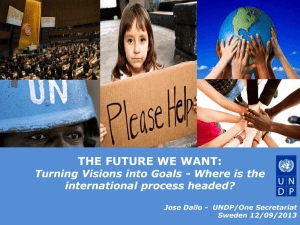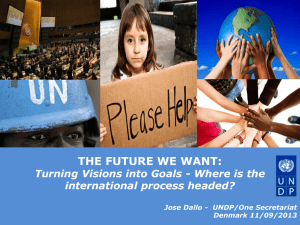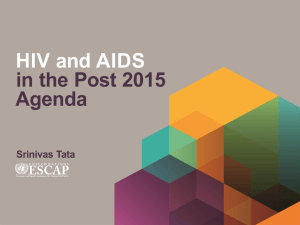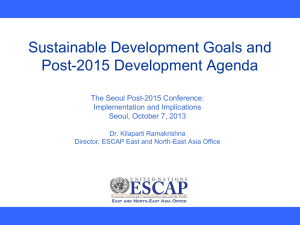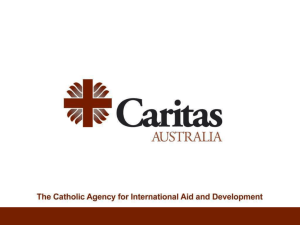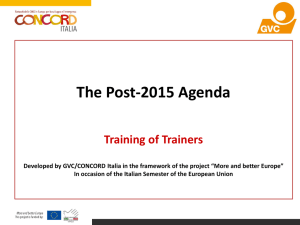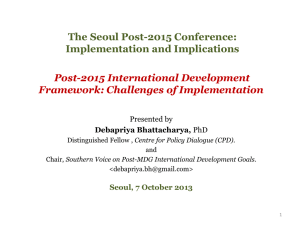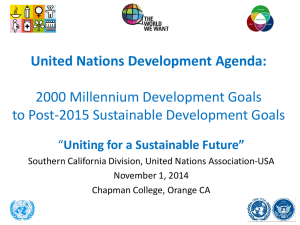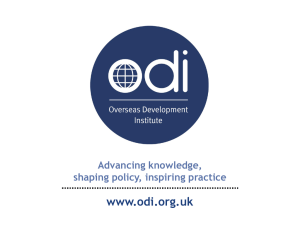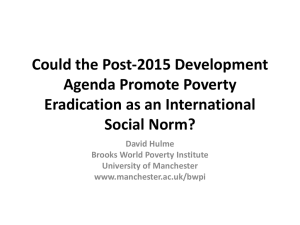PowerPoint Template
advertisement
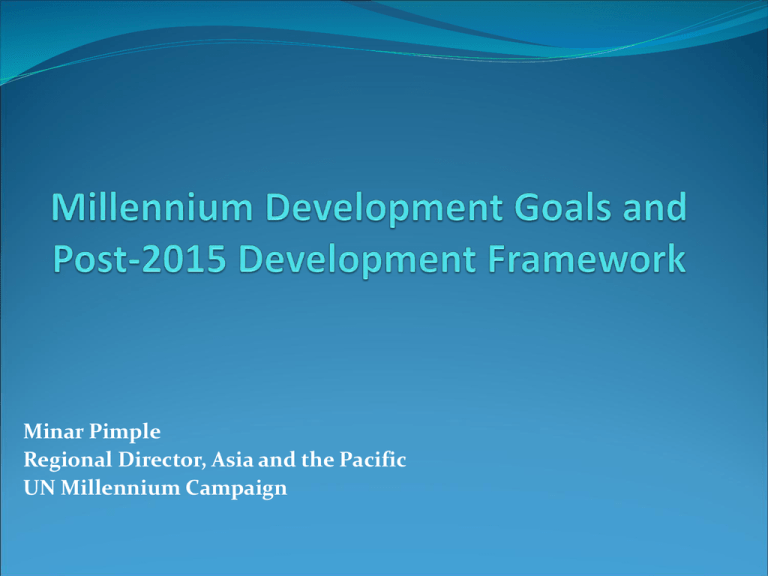
Minar Pimple Regional Director, Asia and the Pacific UN Millennium Campaign I. Learning from the MDGs What should the Post-2015 Development Framework look like? History of the MDGs International Development Goals (IDGs) emerged from a series of international conferences (e.g. gender, children, health, education and population) in the 1990s. In 2000, the Millennium Declaration was adopted but did not contain the MDGs in their present form. In 2001, a team of UN experts created the MDGs with indicators, without any inter-governmental process. “I and several of [Kofi Annan’s] staff literally went into the proverbial windowless committee room and wrote the MDGs. I have spent many a year since wishing I had taken a little more time to write them as I might have made them slightly more inclusive and polished.” (Mark Malloch Brown, former UNDP Administrator, Feb 2011) Mainly European donors supported the MDGs, while the MDGs faced strong opposition and skepticism from many governments as well as Northern and Southern NGOs for the initial five years. By the latter half of the decade, the MDGs had gained traction and became an important organizing principle for a large number of development actors. Strengths of the MDG Framework Driven by donors, MDGs had most impact on donors and aid levels. The limited number of goals and targets on which there is global consensus and through which popular support and political action can be mobilised. MDGs provided useful leverage for arguing for increased aid volumes. (i.e. Millennium Project’s estimated resource requirement became the target for G8 in Gleneagles in 2005.) MDGs contributed to focusing aid on the social sectors in general and on some specific areas, such as primary education and child health. MDGs became a useful vehicle for CSOs to hold their governments to account for the public promise. MDGs encouraged the collection of better data to assess their progress. Weaknesses of the MDG Framework Lack of participation in the formulation process, which created resentment among many developing country governments as “donor /UN driven agenda” Some argue that by focusing on social sectors, MDGs have effect of reducing the importance attached to aid focused on infrastructure, agriculture and industrial development . Masking inequalities by focusing on the global and national averages. Lack of commitments by rich countries with the Goal 8 without specific quantified targets or dates. MDGs left out some key issues of importance to development (e.g. climate change, conflict, security, disability). Translation of global goals into nationally applicable targets and policy making was inappropriate for some countries with completely different development trends. Emerging scenarios There is an emerging consensus on formulating a new agenda which retains the simplicity and the affirmative action nature of the MDGs, supplemented with other goals and targets reflecting the changed global context At the same time, there is a corner advocating for simply extending the time scale of the existing MDGs due to its current traction as well as the fact that many key Goals are likely to be missed. Critical issues & changed international context Revisiting values and principles of Millennium Declaration Sustainable Development Goals (SDGs) and climate change Inequality, vulnerability and exclusion Jobless growth and growth with low quality employment Migration and urbanization, with increasing global population Poverty in middle-income countries Financial and economic crises making donor countries more inward-looking New multilateralism particularly among emerging economies (e.g. China, India and Brazil) Proposals for Post-2015 development agenda Main themes o Human rights o Inequalities o Sustainability Specific themes Population dynamics Peace and security Stable and inclusive economic growth Productive employment and decent work Food security Governance (including principles of inclusion & participation, promoting transparency & accountability) o Building resilience of vulnerable population groups o o o o o o Emerging Post 2015 key messages The core values contained in the Millennium Declaration remain valid: The Post 2015 framework is an opportunity to incorporate issues that were part of the Millennium Declaration but were not reflected in the MDGs – e.g. human rights, environmental sustainability, peace and security The Post 2015 development agenda must be universally applicable but flexible to meet specific needs of countries and peoples Global partnerships must be re-defined to make it truly “global” with a clear accountability framework for both developed and developing countries II. Processes to Formulate a Post-2015 Development Framework Call for a participatory, inclusive process There is a general understanding that the Post-2015 must not repeat the shortcomings of the MDGs. UNSG as well as civil society coalitions call for a more participatory, inclusive process which is responsive to the voices of people directly affected by poverty and injustice. However, preparatory processes and consultations for Rio +20 have so far failed to meaningfully integrate CSOs at the national level. UN-wide communications and outreach function is being established to gather inputs and feedback from civil society and facilitate dialogue on post-2015 framework, using a new web platform. Ongoing initiatives on participatory post-2015 discourses 1) UN Development Group project on Post-2015 consultations National consultations in 50 countries, including: Bangladesh, China, India, Indonesia, Lao PDR, Pakistan, PNG, Solomon Islands, Timor-Leste and Vietnam 9 thematic consultations on key themes and cross-cutting issues (themes to be finalized) Global conversations with three sub components: mobilization, web platform and crowd-sourcing 2) “Breaking Point” research project (jointly by the Commonwealth Foundation & UN Millennium Campaign) Including: India, Nepal, Pakistan, the Philippines, Sri Lanka and Samoa UNDG Communications and Advocacy Strategy UNDG has developed an integrated communications and outreach strategy aiming to harmonize efforts on MDGs, Rio+20 and Post-2015, Key Focus: 1) Reminding the commitments to and principles of the Millennium Declaration (i.e. freedom, human rights, equality, solidarity, tolerance, respect for nature) in achieving the MDGs and developing a new agenda. 2) Emphasizing the positive gains by the MDGs and the need for unwavering commitment to the MDGs in the remaining years until 2015. Roadmap to 2015 – Major UN and CSO processes Dec 2011 March 2012 April 2012 GA Resolution mandating SG to initiate the Post-2015 process UNDP and UNDESA draft papers on UN’s vision and roadmap Meetings on post-2015 held: by Berlin Civil Society Centre; by UNMC; and by UNICEF and Save the Children May 2012 Post-2015 meeting by Beyond 2015 May 2012 – Q1 of 2013 UN national consultations on Post-2015 June 2012 Rio+20 UN Conference on Sustainable Development July 2012 UNSG appoints a High Level Panel of Eminent Persons Sep 2012 CIVICUS General Assembly (many meetings on post-2015) Feb 2013 UN High Level panel to deliver report Sep 2013 UN Special Session on the MDGs 2014 – 2015 Intergovernmental negotiation process on post-2015 Post 2015 ASG High Level Panel 2013 SG Report High Level Event Informal Influence Informal Influence Post 2015 Outreach Strategy Group Global Conversation Digital Platform UNDG 50 Country Consultations and 9 Thematic Consultations Crowdsourcing/Aggre gation Expert Group Mobilisation UN Task Team Rio+20 /SDGs Useful Resources ‘The World We Want – Beyond 2015’ A Toolkit for National Deliberations (A partnership publication by: GCAP, Beyond 2015 and the UN Millennium Campaign) Thank you for your attention
